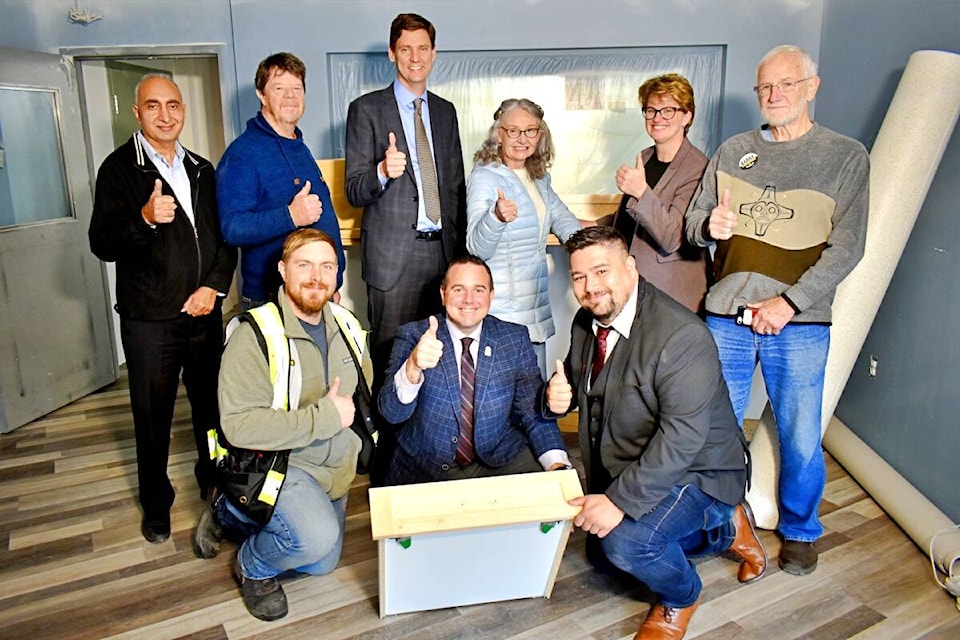Three thousand to 5,000 new housing units are required in Prince Rupert to support industry, and the growth of the port, David Eby, NDP leadership candidate, former Attorney General and Minister Responsible for Housing, heard on Oct. 12 during a visit to the city.
He also heard the muskeg in the area is a foundational prohibition for developers.
Mayor Lee Brain explained on a tour of a new transitional housing facility, in which Eby, city councillors, and MLA Jennifer Rice were participants, Prince Rupert is a community in which “housing means everything” and affordable housing is what is essential.
“Rupert is ready. Rupert is ready to get moving,” Brain said, explaining developers are already on their way to build market housing, but more affordable housing is needed.
“We’ve identified the priority areas … In terms of affordable [supply], we could probably put a dozen projects together immediately with the properties we have,” he said, adding BC Housing is already aware of this.
Rice said positive feedback had been received regarding the NDP efforts on supportive housing but questioned what is being done for seniors and middle-income people.
“We’ve lost doctors, social workers, nurses, teachers, all because they need to find middle-income units,” Rice said. “We have the oldest housing stock in BC. We have the most homes built before 1922 and the most homes built before 1940. We could count on two hands the number of new homes built in the last decade.”
The muskeg and bedrock are problems for developers who can build the same housing in Smithers or other locations for a fraction of the cost. She said that one developer has the numbers worked out to such a fine point that he knows it costs approximately three cents more per nail to build in Prince Rupert.
“It’s not attractive to developers. They say it to our face …” Rice said.
Brain said it cost more than $1 million just for the foundation of a recent supportive housing project to be laid due to the high cost of excavation which had hundreds of dump trucks hauling away muskeg and dirt. It’s a challenge of the Rupert terrain that is unique to the city, he said.
According to Brain, one of the solutions for the city to attract more developers is to clear and prepare lots for construction. It’s a catch-22 because then there is nowhere for the ground debris to go.
Also, a deterrent to property developers is the lack of available timelines. It’s not efficient for builders to do a one-time job with crews mobilized and materials shipped up here, the mayor said.
“They want to have a five-year plan for Rupert, but there is no ability to do that right now,” he said.
Eby responded in an interview with The Northern View and said the core of his proposed housing plan, if he becomes premier, is to work with local governments on middle-income housing to address and remedy whatever unique issues prohibit development.
“The province has some powers and the cities have some powers. The province has land, the city has land. We each have tools we can bring to respond to local issues,” he said, adding site preparation is a great idea for Prince Rupert.
He said some risks could be taken out of the sites by the province supporting ground preparation in exchange for affordability guarantees.
“[We could] also provide assurances around a number of units so a developer that maybe isn’t operating in Prince Rupert would consider coming here and building housing on a larger scale,” Eby said.
The bottom line is for families, he said and if affordable homes aren’t built, if developers aren’t here to construct those homes, then there is no place for people to buy or rent. This perpetuates existing housing becoming more expensive, leading to more homelessness and people living in substandard conditions, he said.
Eby also addressed the costs of shipping materials to the city as another challenge developers face.
“It seems strange that a town with such a big and vibrant port would be struggling with the cost of building materials related to shipping them here. But I think it’s also a function of the fact that there’s been such a challenge for developers to come here to build housing at the scale that Prince Rupert needs and for what the demand is in this growing community.”
The previous Minister responsible for housing said that if government support can be provided in the delivery of the thousands of housing units needed in the city, then due to the scale, some building costs may be reduced.
Eby said while his housing plan responds to a province-wide issue, the housing crisis is a national issue. However, he sees that work is needed with each municipality to address the issue that is driving up housing costs. Each city faces different challenges and Prince Rupert it’s the muskeg.
“Each city needs a different solution. Some of them have issues in common, but I’m finding that the issue is slightly different in each community and we need to work closely with local government to address those issues,” he said.
